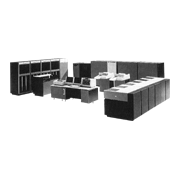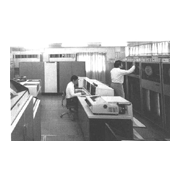These were announced in 1974 as the first large machines in the ACOS Series 77. Their product names were "ACOS Series 77, System 600 and 700", but they were known as the ACOS 600 and 700.
The ACOS Series 77 large machines were developed based on the TOSBAC-5600, and attempted to deal with the difficult issue of upgrading the architecture while maintaining compatibility. Their features included: (1) MSI, which was a state-of-the-art technology at the time, (2) Cache memory in a multi-processor configuration, (3) A virtual memory system (with maximum program space of 64MB) employing distributed/dynamic main memory management based on the segmentation system and paging system, (4) A sophisticated access control system based on the domain protection system, (5) Comprehensive RAS design based on an online hardware self-diagnosis function, and (6) Shared libraries based on a shared segment mechanism.
In 1976, Toshiba announced a higher-end version of the ACOS 600 and 700 called the System 800 (ACOS 800).
The System 800 employed cutting edge technologies such as: (1) Use of micropackage technology for sealed mounting of CML chips in TAB form onto a thick-film ceramic board, and (2) Error detection by using 2 processors, and comparing the results of the two processors every clock cycle. In that same year, the System 900 was also developed, as a model with enhanced performance, by developing new floating point mechanism hardware for scientific and engineering computation.
Also in that same year, the System 600S (ACOS 600S) was marketed as a model to cover the mid-range machine price range. As a CPU, it used the AMD2901 bit slice microprocessor from AMD. It had a lower price, and used microprogramming to achieve complete compatibility with the other ACOS Series 77 large machines.



